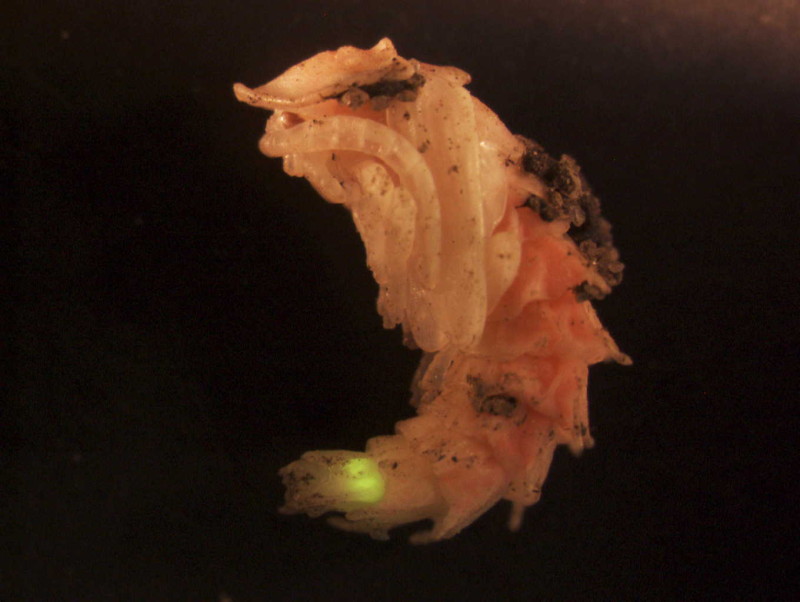美国科学家发现Hox基因新功能 点亮萤火虫之光

在动物王国中,一个难以解释的新奇单一进化方式,无非就是令人着迷和好奇的萤火虫之光。直到今天,还没有人知道萤火虫发光结构的形成和演化的遗传基础。
但是现在,由印第安纳大学伯明顿分校的研究生及他的IU博士导师首次提供这种新奇壮观结构的一个遗传基础表征——萤火虫的发光器官——以及这种甲虫成功地利用古老而高度保守的调控基因形成这个发光的灯笼的方法。
“我们的研究发现两种Hox基因前所未知的作用,”文科学院的副教授Armin Moczek说。
“这些基因在长时间的进化中高度保守奠定如此多动物的基础机体形态形成,从人类到苍蝇。我们的研究表明,最重要的是,Hox基因在萤火虫发光器官发育中发挥很重要的作用。”
Hox基因是生物体中一类专门调控生物形体的基因,如头部,胸部和昆虫的腹部,或颈椎,胸椎和哺乳动物的腰椎。
一种几乎前所未有的现象,然而,就在一个大约有2000种甲虫的大家族中,发现两个Hox基因abdominal-A (abd-A)和 Abdominal-B (Abd-B),似乎获得一种调节一种全新的,复杂的器官——灯笼的能力。
“一个不受旧有观念的束缚,认为Hox基因能够快速适应新的职责,这是比较新颖的,” Moczek说。“这是相对较少的一个例子,证明这的确发生在动物进化。”
Stansbury和Moczek通过下调这两个基因的功能——这两个基因被要求适当调控成虫的发光器官形成。
“特别是,Abd-B Hox基因在发光器官各方面形成至关重要。这表明它已进化出一种新颖的特殊光互动调控功能。”Moczek说。他们还发现,Abd-B能够抑制萤火虫的发光器官的腹部色素沉着,从而创造出半透明的角质层,使光逃脱机体内部。此外,大多数昆虫的第六和第七腹节通常仅是由Abd– A调控,而不是Abd-B。然而,正是这些萤火虫发光器官的腹节表明,Abd-B的功能很可能在很久以前就扩展了。这是一个大问题,因为Hox基因,鉴于其在确立基本的身体构造非常重要的功能,通常将它们局限于表达严谨及高度保守范围内。
“这仅仅是个开始,” Moczek说。“我们想知道abd-A和Abd-B是如何相互作用形成器官的。我们想要精确基因产物激活的时间和地点;以及我们想要更多了解,有关如何从幼虫器官——位于另一个段一个更简单的结构,进化成成熟的器官。” 他补充说。
Moczek对于调查新特征并不陌生,其中一个例子是Hox基因独立特意的介导途径——真的,独特的创新——比普遍更加广泛流传。另一例子是Moczek的主要研究领域之一——甲虫角:甲虫角的一个新颖特征是缺乏其他特征对应的甲虫或昆虫。
Hox基因(homeobox)DNA序列被1983年IU特聘生物写教授汤姆考夫曼实验室的学生发现的。
“这项研究首次揭示这种生物的发光结构,希望未来能够挖掘更多的这种神奇昆虫的秘密。” Moczek说。这项研究发表在《英国皇家学会学报B》杂志上。
原文摘要:
The function of Hox and appendage-patterning genes in the development of an evolutionary novelty, the Photurisfirefly lantern
Matthew S. Stansbury and Armin P. Moczek
Uncovering the mechanisms underlying the evolution of novel traits is a central challenge in biology. The lanterns of fireflies are complex traits that lack even remote homology to structures outside luminescent beetle families. Representing unambiguous novelties by the strictest definition, their developmental underpinnings may provide clues to their origin and offer insights into the mechanisms of innovation in developmental evolution. Lanterns develop within the context of abdominal Hox expression domains, and we hypothesized that lantern formation may be instructed in part by these highly conserved transcription factors. We show that transcript depletion of Abdominal-B in Photuris fireflies results in extensive disruption of the adult lantern, suggesting that the evolution of adult lanterns involved the acquisition of a novel regulatory role for this Hox gene. Using the same approach, we show that the Hox gene abdominal-A may control important secondary aspects of lantern development. Lastly, we hypothesized that lantern evolution may have involved the recruitment of dormant abdominal appendage-patterning domains; however, transcript depletion of two genes, Distal-less and dachshund, suggests that they do not contribute to lantern development. Our results suggest that complex novelties can arise within the confines of ancestral regulatory landscapes through acquisition of novel targets without compromising ancestral functions.
标签: 萤火虫 印第安纳大学 Hox基因
作者:生物帮

